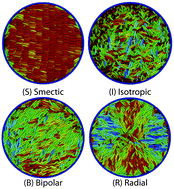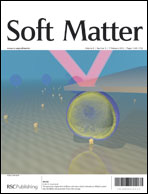Liquid crystal nanodroplets, and the balance between bulk and interfacial interactions
Abstract
Molecular dynamics simulations of a coarse grain model are used to explore the morphology of thermotropic liquid crystal nanodroplets. The characteristic length of the droplets is such that different contributions to the energy, including interfacial and bulk-like terms, have comparable magnitudes. Depending on the relative strength of such contributions, a wide variety of mesophases can be identified. These range from a completely disordered isotropic phase at elevated temperatures, to ordered radial and smectic phases at low temperatures. Bipolar, uniaxial and axial phases are also observed. Our results suggest that according to the ratio between perpendicular and planar anchoring strengths, an isotropic–radial transition may occur through several intermediate phases. In contrast, a direct bipolar–radial transition is never observed. Our results are summarized in the form of a generic phase diagram for spherical nanodroplets as a function of anchoring strength. The diagram exhibits a number of common features with phase transitions that have been observed in experiments with larger, micron-sized droplets. Perhaps more importantly, it serves to emphasize the balance that exists in nanodroplets between surface and bulk interactions, droplet size and temperature, and how that balance influences the behavior of the system.


 Please wait while we load your content...
Please wait while we load your content...